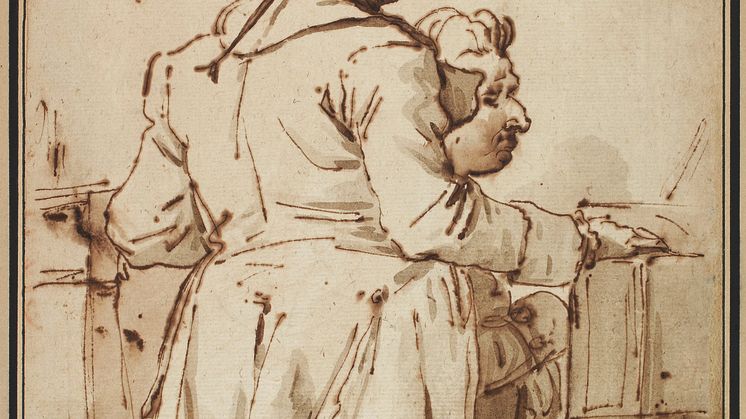
Press release -
New acquisition: Vincent’s portrait of his friend Sergel
Nationalmuseum
has acquired a previously unknown portrait of Johan Tobias Sergel drawn in 1774
by his French colleague and friend François-André Vincent. The pen-and-wash
drawing is an unusually vivid image of the Swedish sculptor in the artistic
environment of Rome. Despite its style, Vincent’s portrait is not a caricature
but rather a snapshot captured by a friend and fellow artist.
In the late summer of 1767, the 27-year-old sculptor Johan Tobias Sergel arrived in Rome on a scholarship from the Swedish government. A diligent and gifted student with a warm and generous personality, he soon became a central figure among the colourful crowd of fellow foreign students that surrounded him in Italy.
One of the earliest friendships Sergel made among the students at the French Academy in Rome was with a group of four painters: Joseph Barthélèmy Le Bouteux, Jean Simon Berthèlemy, Joseph Benoît Suvée and François-André Vincent. When they were not studying, Sergel and Vincent spent most of their time creating a series of slightly caricatured candid portraits of their colleagues and friends. In a famous drawing now in Nationalmuseum’s collection, Sergel captured the Frenchman’s haughty demeanour and aristocratic features with a few strokes of his reed pen.
However, the portraits of Sergel by François-André Vincent (1746–1816) have long languished anonymously in private ownership. In 1974 the Metropolitan Museum of Art in New York, through an American gallerist, managed to acquire one of them, showing Sergel seated at a clavichord in Rome in 1774. As luck would have it, exactly 40 years later, another Sergel portrait has now come into the possession of the same gallerist and been purchased by Nationalmuseum. In the newly acquired portrait, Sergel is depicted from behind, and slightly to one side, as statuesque and somewhat stocky. He is wearing a tricorne (three-cornered hat), a wig with a pigtail, and a long, fashionable coat with a buttoned-up slit.
It is noteworthy that not only are the two drawings signed and dated the same year (1774), but they also appear to have been drawn on the same occasion. The setting, with the clavichord and the sideboard in the background, is identical, as is the technique. Both drawings are on paper of the same size and the same uncoated type, which has caused the ink lines to bleed into the paper fibres.
Nationalmuseum’s purchase of this previously unknown portrait of Sergel has been made possible by a generous donation from the Axel and Nora Lundgren Fund. Nationalmuseum has no budget of its own for new acquisitions, but relies on gifting and financial support from private funds and foundations to enhance its collections of fine art and craft.
Further information
Ulf Cederlöf, senior curator collections, ulf.cederlof@nationalmuseum.se, +46 8 5195
4402
Caption
François-André
Vincent, Portrait of Sergel, 1774.
Photo: Nationalmuseum
Categories
Nationalmuseum is Sweden’s premier museum of art and design. The collections comprise older paintings, sculpture, drawings and graphic art, and applied art and design up to the present day. The museum building is currently under renovation and scheduled to open again in 2017. In the meantime, the museum will continue its activities through collaborations, touring exhibitions and a temporary venue at the Royal Swedish Academy of Fine Arts, Fredsgatan 12, Stockholm. Nationalmuseum collaborates with Svenska Dagbladet, Fältman & Malmén and Grand Hôtel Stockholm. For more information visit www.nationalmuseum.se.

